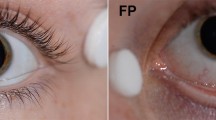Abstract
We sought to determine whether routine ERGs using ISCEV standard stimuli, would show a pattern of circadian variation. We examined ERGs from 40 successive normal subjects who were tested at different times during regular laboratory operating hours of 9 am to 4 pm, and also reviewed high intensity a-waves from a subgroup. There were no obvious associations of either ERG amplitude or implicit time with time of day. No statistically significant difference was found between average ISCEV ERG parameters or high-intensity a-wave parameters obtained in the morning (9 am to 1 pm) and afternoon (1 pm to 4 pm). We conclude that time of day is not critical for routine ERG recordings, although small, variable, circadian changes may well be present. We suggest that the time of day be noted on clinical recordings, in case this information becomes relevant for a particular patient.
Similar content being viewed by others
References
Anderson DH, Fisher SK, Erickson PA, Tabor GA. Rod and cone disc shedding in the rhesus monkey retina: a quantitative study. Eye Res 1980; 30: 559–574.
Ronchi L. Intra-day variations in visual responsiveness. Space Life Sci 1973; 4: 231–239.
Nozaki S, Wakakura M, Ishikawa S. Circadian rhythm of human electroretinogram. Jpn J Ophthalmol 1983; 27: 346–352.
Hankins MW, Jones RJM, Ruddock KH. Diurnal variation in the b-wave implicit time of the human ERG. Vis Neurosci 1998; 15(1): 55–67.
Hankins MW, Jones SR, Jenkins A, Moreland AB. Diurnal daylight phase affects the temporal properties of both the b-wave and d-wave of the human ERG. Brain Res 2001; 889(1-2): 339–343.
Birch DG, Berson EL, Sandberg MA. Diurnal rhythm in the human rod ERG. Invest Ophthalmol Vis Sci 1984; 25: 236–239.
Birch DG, Sandberg MA, Berson EL. Diurnal rhythm in the human rod ERG. Relationship to cyclic lighting. Invest Ophthalmol Vis Sci 1986; 27(2): 268-270.
Birch DG. Diurnal rhythm in the human rod ERG: retinitis pigmentosa. Invest Ophthalmol Vis Sci 1987; 28(12): 2042–2048.
Rufiange M, Dumont M, LaChapelle P. Correlation of retinal function with melatonin secretion in subjects with early or late circadian phase. Invest Ophthalmol Vis Sci 2002; 43(7): 2491–2499.
Tuunainen A, Kripke DF, Cress AC, Youngstedt SD. Retinal circadian rhythms in humans. Chronobiol International 2001; 18(6): 957–971.
Marmor FM, Zrenner E. Standard for clinical electroretinography. Doc Ophthalmol 1999; 97: 143–156.
Hood DC, Birch DJ. Light adaptation of human rod receptors: the leading edge of the human a wave and models of rod receptor activity. Vis Res 1993; 33(12): 1605–1618.
Cideciyan AV, Jacobson SG. An alternative phototransduction model for human rod and cone ERG a-wave: normal parameters and variation with age. Vis Res 1996; 36(16):2609-2021.
Birch DG, Anderson JL. Standardized full-field electroretinography. Normal values and their variation with age. Arch Ophthalmol 1992; 110: 1571–1576.
Jacobi PC, Miliczek K-D, Zrenner E. Experiences with the international standard for clinical electroretinography: normative values for clinical practice, interindividual and intraindividual variations and possible extensions. Doc Ophthalmol 1993; 85: 95–114.
Birch DG, Hood DC, Locke KG, Hoffman DR, Tzekov RT. Quantitative electroretinogram measures of phototransduction in cone and rod photoreceptors: normal aging, progression with disease, test-retest variability. Arch. Opthalmol 2002; 120(8): 1045–1051.
Sandberg MA, Baruzzi CM, Hauson AH III, Berson EL. Rod ERG diurnal rhythm in some patients with dominant RP. Invest Ophthalmol Vis Sci 1988; 29(3): 494–498.
Author information
Authors and Affiliations
Rights and permissions
About this article
Cite this article
Marcus, M., Cabael, L. & Marmor, M.F. Are Circadian Variations in the Electroretinogram Evident on Routine Testing?. Doc Ophthalmol 108, 165–169 (2004). https://doi.org/10.1023/B:DOOP.0000036844.67273.1b
Issue Date:
DOI: https://doi.org/10.1023/B:DOOP.0000036844.67273.1b




